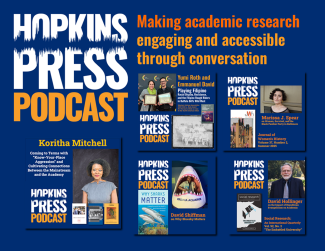by Greg Britton
For University Press Week, JHUP’s editorial director considers the future of scholarly publishing.
Most attempts to imagine the future fall short. This becomes more true the more specific our guess is. In
Back to the Future II, Doc Brown sets the clock on his time machine ahead precisely to October 21, 2015. Of course, the filmmakers got most details of what life would be like in 2015 wrong. Over breakfast that actual morning, my daughter asked why we didn’t have hoverboards. The only thing I could think to say was, “because we don’t have a flux capacitor strong enough.”

What did Stanley Kubrick get right in
2001: A Space Odyssey? Those teaching the novel
1984 know they have to remind students that George Orwell was writing about the future he saw, one that now predates their own birth. In his 1895 novella
The Time Machine, H. G. Wells had the good sense to set the future far enough away—802,701 AD, to be precise—thus avoiding such disappointments. As humans we have a primal desire to predict the future, which is remarkable because we are so bad at it. It’s easy to guess, hope, or even dread what’s around the chronological corner, but it is almost impossible to get it right.
So it is with questions about the future of the scholarly publishing. I was first asked to speak about the “Future of the Book” in the early 1990s back when symposia like this were happening everywhere. Guessing what would happen wasn’t particularly hard, but looking back at what I said now makes me cringe. I got almost nothing right: books didn’t go away, nor did independent bookstores. The codex wasn’t supplanted by files delivered on floppy disk or CD-ROM. Although we did see a dramatic consolidation in trade publishing, it left remarkable opportunities for upstart independent and scholarly publishers. The Internet was only a hint of what it is today. It was a world before Amazon and a sole surviving bookstore chain. We had not yet heard of Kindles, apps, or smartphones. Still, we feared that the book, a five-hundred-year-old technology, was on its deathbed.
In thinking back to those early conversations, it seems that any predictions about format were wrong. The book didn’t go away, but it morphed into a fascinating array of other delivery systems. We can read books on our laptops, our phones, our televisions, and, well, on paper. In the future, we can anticipate that formats won’t really matter—readers will chose how they want the content when and where they want it. Content will leapfrog from technology to technology.
Second, we might anticipate that content will be infinitely more interactive than it is now. We see hints of this with adaptive learning systems that tailor content to a students’ needs. I imagine a time when books will communicate with each other, forming a true network of information that links content across time and space. Readers, too, will communicate with each other through annotations; entire conversations will happen alongside the text itself.
To do this, it will be essential for publishers to become hyper-cooperative not just with each other (around common technologies, copyrights, and standards), but with librarians, technologists, scholarly societies, and the scholars themselves. It is utopian to imagine a library of the world’s knowledge, but who would have predicted the improbable success of Wikipedia two decades ago? Scholarly publishing has always been a group effort. Collaboration will be essential in the future.
So, what is the future of scholarly publishing? I will hazard a guess. I think it will be innovative, interactive, and multimodal. It will be collaborative, interdisciplinary, and global. It will be essential. I can say this with even greater confidence: it will be really, really cool. And, of course, I will come to work on a hoverboard if we can build a flux capacitor strong enough.
Greg Britton is the editorial director in the books division at Johns Hopkins University Press. Follow him on Twitter at @gmbritton



